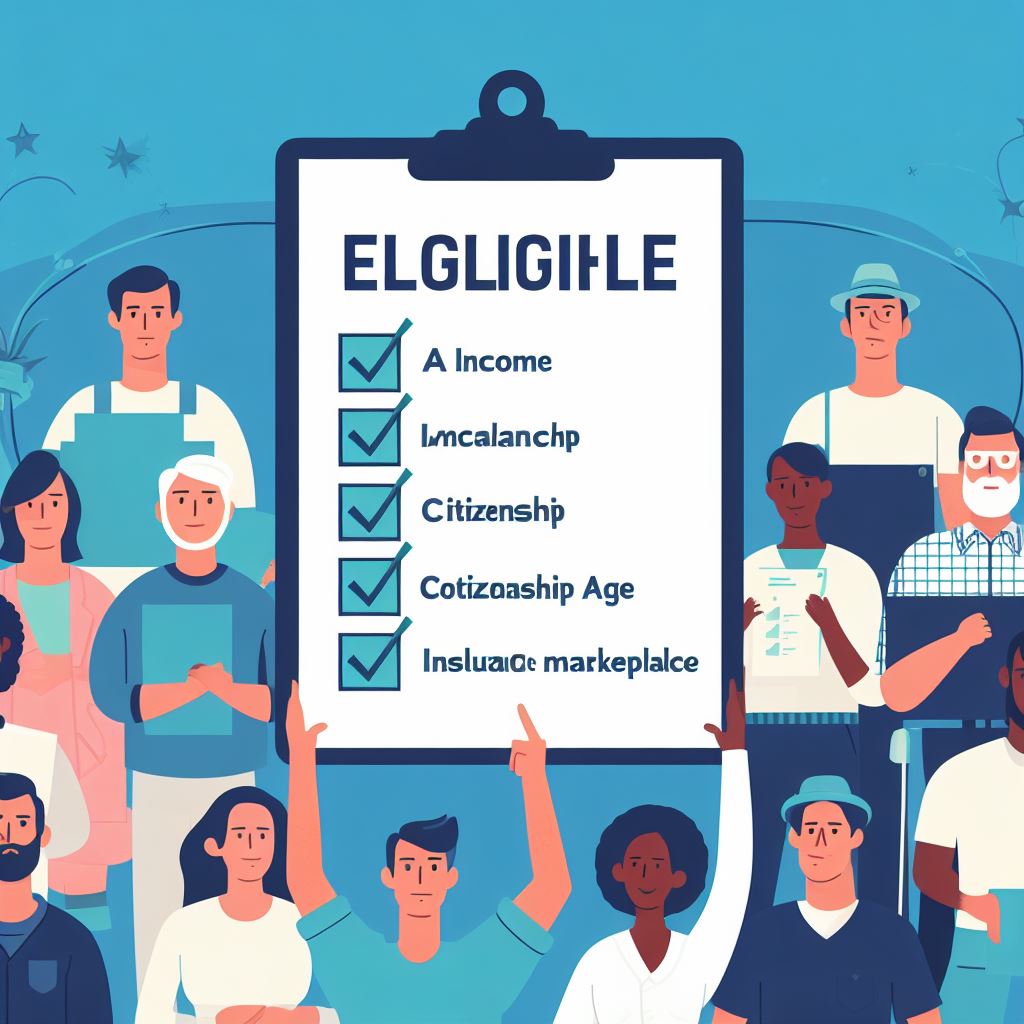Eligibility Criteria: Your Path to ACA Insurance Marketplace

Ready to navigate your way through the ACA Insurance Marketplace? Look no further!
This article is your compass, providing the essential eligibility criteria for enrollment. From income requirements to citizenship status, employer-sponsored coverage to Medicaid and CHIP eligibility, we’ve got you covered.
Stay tuned to learn about the enrollment period and deadlines, ensuring you don’t miss out on your chance for comprehensive health insurance.
Let’s dive in and embark on your path to affordable coverage.
Key Takeaways
- Income requirements must be met in order to qualify for insurance coverage through the ACA Insurance Marketplace, and subsidies are provided based on household income and family size.
- Citizenship or immigration status must be confirmed for eligibility, with U.S. citizens, nationals, and lawfully present immigrants generally eligible, while undocumented immigrants are not.
- Employer-sponsored coverage options should be understood, such as group health insurance plans or health reimbursement arrangements, which may affect eligibility for subsidies.
- Eligibility for Medicaid and CHIP varies by state, with Medicaid providing coverage for low-income individuals and CHIP providing coverage for children in low-income families. Some states have expanded Medicaid eligibility.
Income Requirements
To qualify for insurance coverage through the ACA Insurance Marketplace, you must meet certain income requirements. The Affordable Care Act (ACA) provides subsidies to help lower-income individuals and families afford health insurance. These subsidies are based on your household income and family size.
The ACA uses a metric called the Federal Poverty Level (FPL) to determine eligibility for these subsidies. The FPL is updated annually and varies depending on the number of people in your household. In general, if your household income falls between 100% and 400% of the FPL, you may be eligible for premium tax credits that can significantly reduce the cost of your health insurance premiums.
It’s important to note that even if your income exceeds 400% of the FPL, you can still purchase insurance through the Marketplace, but you won’t be eligible for premium tax credits. Understanding your income and how it relates to the FPL is crucial in determining your eligibility for subsidies through the ACA Insurance Marketplace.
Moving on to the next eligibility requirement, citizenship and immigration status…
Citizenship and Immigration Status
To determine your eligibility for insurance coverage through the ACA Insurance Marketplace, you’ll need to confirm your citizenship and immigration status. The Affordable Care Act (ACA) requires individuals to be either U.S. citizens or have eligible immigration status to qualify for coverage. U.S. citizens, nationals, and lawfully present immigrants are generally eligible for ACA health insurance plans. However, undocumented immigrants aren’t eligible for coverage through the Marketplace.
To confirm your citizenship or immigration status, you’ll need to provide documentation. U.S. citizens can use their birth certificates or passports as proof of citizenship. Lawfully present immigrants can use their immigration documents, such as their green cards or employment authorization cards, to establish their eligibility.
It is important to note that the ACA prohibits the sharing of immigration status information with immigration enforcement agencies. This means that applying for health insurance through the Marketplace won’t affect your immigration status or put you at risk of deportation.
Understanding your citizenship and immigration status is crucial when determining your eligibility for ACA health insurance coverage. By confirming your status and providing the necessary documentation, you can ensure that you meet the requirements and access the healthcare coverage you need.
Employer-Sponsored Coverage
Confirming your eligibility for ACA insurance coverage through the Marketplace includes understanding the options available for employer-sponsored coverage.
Employer-sponsored coverage refers to health insurance plans provided by employers to their employees. These plans can vary in terms of coverage and cost, so it’s important to understand the details before making a decision.
One option is the employer-sponsored group health insurance plan. This type of coverage is offered by large employers and provides comprehensive benefits to employees and their dependents. The premiums for these plans are typically shared between the employer and the employee, making it an affordable option for many individuals.
Another option is the employer-sponsored health reimbursement arrangement (HRA). With an HRA, employers contribute a certain amount of money to an account for each employee. This money can be used to reimburse employees for qualified medical expenses, including insurance premiums. HRAs can offer flexibility and choice as employees can use the funds to purchase their own individual health insurance plans.
It is important to note that if you’re offered affordable employer-sponsored coverage that meets certain minimum requirements, you may not be eligible for subsidies through the Marketplace. However, if the employer-sponsored coverage is deemed unaffordable or doesn’t meet minimum standards, you may still be eligible for ACA insurance coverage through the Marketplace.
Medicaid and CHIP Eligibility
Understanding the options available for employer-sponsored coverage can also help you determine your eligibility for Medicaid and CHIP. These government programs provide healthcare coverage for low-income individuals and families who meet certain criteria.
Here are some key points to consider:
- Medicaid: This program is jointly funded by the federal and state governments and provides healthcare coverage to eligible individuals with limited income. Eligibility criteria vary by state, but generally, you must meet income requirements and fall within certain eligibility categories, such as low-income adults, children, pregnant women, elderly adults, and individuals with disabilities.
- Children’s Health Insurance Program (CHIP): CHIP provides healthcare coverage for children in low-income families who don’t qualify for Medicaid. Eligibility requirements also vary by state, but generally, children must be under a certain age and have a family income below a certain threshold.
- Expansion of Medicaid: Under the Affordable Care Act, some states have expanded Medicaid eligibility to include individuals and families with slightly higher incomes. If you live in a state that has expanded Medicaid, you may be eligible for coverage even if you previously didn’t qualify.
Determining your eligibility for Medicaid and CHIP can be complex, but understanding the options available and the criteria for each program can help you navigate the process and access the healthcare coverage you need.
Enrollment Period and Deadlines
You can enroll in Medicaid and CHIP during specific enrollment periods and deadlines. It is important to be aware of these timeframes to ensure that you don’t miss out on the opportunity to apply for these programs. The enrollment periods and deadlines vary depending on your state, so it is crucial to check with your state’s Medicaid or CHIP office for the specific dates. To help you understand the enrollment periods and deadlines better, here is a table outlining the general timeframes for enrollment:
| Enrollment Period | Start Date | End Date |
|---|---|---|
| Initial Enrollment | January 1 | March 31 |
| Special Enrollment | Varies | Varies |
| Open Enrollment | November 1 | December 15 |
During the initial enrollment period, you have the opportunity to apply for Medicaid or CHIP if you meet the eligibility criteria. The special enrollment period is available for individuals who experience certain life events such as getting married, having a baby, or losing their health coverage. Lastly, the open enrollment period is the designated time each year when you can sign up for Medicaid or CHIP or make changes to your existing coverage. By staying informed about the enrollment periods and deadlines, you can ensure that you have access to the healthcare coverage you need.
Frequently Asked Questions
Can I Apply for ACA Insurance Marketplace Coverage if I Am Unemployed and Have No Income?
Yes, you can apply for ACA insurance marketplace coverage even if you’re unemployed and have no income. The marketplace offers options based on your income level, ensuring that everyone has access to affordable healthcare.
Can Undocumented Immigrants Apply for ACA Insurance Marketplace Coverage?
Undocumented immigrants are not eligible to apply for ACA insurance marketplace coverage. The ACA requires applicants to be lawfully present in the United States, and undocumented immigrants do not meet this requirement.
If My Employer Offers Health Insurance Coverage, Am I Still Eligible for ACA Insurance Marketplace Coverage?
If your employer offers health insurance coverage, you may still be eligible for ACA Insurance Marketplace coverage if the employer’s plan doesn’t meet certain standards or if the cost of the employer’s plan is too high.
How Do I Determine if I Qualify for Medicaid or the Children’s Health Insurance Program (Chip)?
To determine if you qualify for Medicaid or CHIP, you can check your state’s eligibility criteria. Income, family size, and other factors play a role. Don’t hesitate to reach out for assistance in navigating the process.
What Happens if I Miss the Open Enrollment Period for the ACA Insurance Marketplace? Can I Still Sign up for Coverage?
If you miss the open enrollment period for the ACA insurance marketplace, you may still be able to sign up for coverage if you qualify for a special enrollment period or if you qualify for Medicaid or CHIP.



